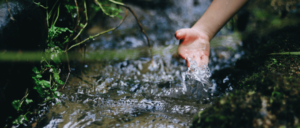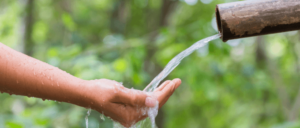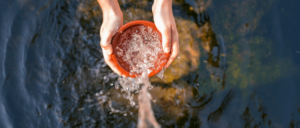How to Get Spring Water at Home? In today’s convenience-driven world, bottled water is often the preferred choice. However, there’s a new way to collect clean, naturally filtered water from your backyard. This involves collecting water from layers of rock, removing impurities, and incorporating nature’s essence into your home, transforming it into a refreshing and environmentally conscious space.
Explore the art of spring water collection, learning to identify and access natural springs. Enjoy the refreshing goodness of nature’s finest water, embracing simplicity and providing your family with the purest, most invigorating water.
Join me on a transformative journey to discover the untapped potential of how to get spring water at home and introduce a new era of home hydration.
Unearthing the Treasure of Spring Water
Spring water naturally purifies through rock and sediment layers in underground aquifers, acquiring a distinct mineral composition. Its constant temperature, refreshing taste, and potential health benefits make it appealing.
Harnessing Nature’s Bounty: Methods for Home Spring Water Collection Create a refreshing oasis in your home by utilizing the natural resources of spring water.
Here are two primary methods for harvesting spring water at home:
Direct Collection from Natural Springs:
- Identifying Spring Locations: To identify potential spring sites, consult local authorities or online resources like SpringMaps.org for mapped spring locations in rocky terrain, hillsides, or near streams.
- Assessing Spring Suitability: Ensure the spring’s flow rate, clarity, and absence of contaminants are monitored, and ensure it is located away from potential pollution sources.
- When collecting spring water: collect it directly from the spring’s source using clean, sanitized containers to prevent any disturbance to the surrounding environment.
Purifying tap water into spring water:
- Water Filtration Systems: Invest in a high-quality water filtration system, preferably one that uses reverse osmosis or activated carbon filtration.
- DIY Filtration Methods: Create a DIY filtration system using natural materials like gravel, sand, and activated charcoal, and replace filter components regularly.
DIY Spring Water Filtration Systems: A Step-by-Step Guide
A DIY spring water filtration system provides a cost-effective and customizable method for water purification.
Here’s the step-by-step guide:
- Gather Materials: Gather a large container, gravel, sand, activated charcoal, cheesecloth, and a clean container for collecting filtered water.
- Layer Filtration Media: Line a container with cheesecloth and add layers of gravel, sand, and activated charcoal, each 2-3 inches thick.
- Pour spring water slowly over the filtration media to allow it to filter through the layers and collect purified water in a clean container.
- Regular Maintenance: Clean and replace the filtration medium regularly for maximum purification
Benefits of Drinking Home-Filtered Spring Water
Using home-filtered spring water has many advantages:
- Purer Hydration: Spring water tastes fresher and more refreshing than tap water.
- Minerals: Calcium, magnesium, and potassium are common in spring water.
- Environmental Consciousness: Reduces bottled water use, reducing plastic and carbon emissions.
- Cost-effectiveness: Eliminates bottled water purchases, saving money.
Healthy Lifestyle: Start Your Spring Water Journey
Incorporate home-filtered spring water into your daily routine for a healthier lifestyle, enjoying its purity, refreshment, and environmental benefits.
Can you make tap water into spring water?
Home filtration systems like reverse osmosis or activated carbon can purify tap water to achieve similar purity and quality as spring water, resulting in cleaner, more palatable drinking water.
What is 100% natural spring water?
True spring water, originating from an underground source, is 100% natural due to its unaltered state and absence of artificial processing. It has filtered through layers of rock and sediment, acquiring its unique mineral composition and distinct taste.
Is spring water hard or soft?
The hardness of spring water depends on the mineral content it acquires as it filters through the earth’s layers. If the water encounters rocks rich in calcium and magnesium, it becomes harder. Conversely, if the water flows through rocks with low mineral content, it remains soft.
Is spring water healthy?
Further research is needed to determine if spring water, with its natural filtration process and potential mineral content, can truly provide health benefits such as improved bone health and reduced risk of heart disease.
Is spring water 100% clean?
Spring water, considered cleaner than tap water, may contain contaminants like sediment, bacteria, or chemicals from agricultural runoff or industrial activities, making it crucial to assess its suitability before consumption.
Harvesting spring water at home not only quenches thirst but also promotes a healthier, sustainable lifestyle, demonstrating commitment to well-being and the planet’s well-being.
Gain knowledge and techniques to transform your home into a refreshing and environmentally conscious space. Enjoy the satisfaction of providing your family with the purest, most invigorating water, a gift from nature.
Explore our resource page on spring water collection and purification to understand its benefits, the science behind its formation, home collection methods, and the health implications of spring water consumption. Discover diverse methods and explore the science behind spring water’s formation.
Subscribe to our newsletter to stay updated on research in spring water and learn new methods for home collection and purification. This challenge encourages you to embrace purity and embark on a transformative journey towards a healthier, more environmentally conscious future.
You have the power to make a difference, so embrace purity and embrace spring water.
![How to Get Spring Water at Home [Step by Step]](https://typeswater.com/wp-content/uploads/2023/12/how-to-get-spring-water-at-home.png)



Leave a Reply